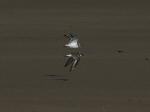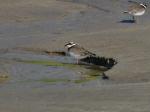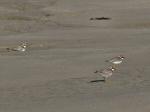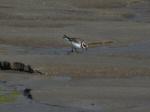Latin Name - Charadrius hiaticula
Larger than its cousin, the Little Ringed Plover, and with a distinctive
white wing bar the Ringed Plover is usually found in coastal habitats.
It is a small, rather dumpy, short-legged wading bird with sandy-brown
upper parts and whitish under parts. It has an orange bill with a dark
tip, orange legs and a black-and-white pattern on its head and breast.
It feeds by running along sandy beaches or estuarine mud picking up flies,
crustaceans and molluscs. It nests on sandy or shingle beaches although
it has spread inland to utilise river margins and flooded quarries. They
nest on the ground in an open area with little cover. If a predator approaches
the nest, the adult will attempt to lead it away by walking away feigning
a broken wing. Once the intruder has been led far enough away from the
nest, the plover flies off.
Resident in Britain, our native population is swelled by influxes of
birds from Europe in the winter months. Other ringed plovers nest in summer
in Greenland and north east Canada and visit us during their annual migration
to and from coastal areas of Africa.
|







